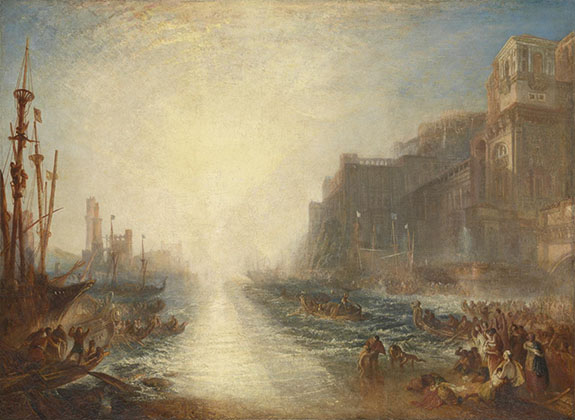 |
.jpg) |
Of course, there are other biographical facts that separate the two artists. One is that Pollock died young (at age 42), while Turner lived into his mid-70s (1775 to 1851). After 1938, Pollock was pretty much a stay-at-home, never traveling far from New York City. On the other hand, Turner’s penchant for travel seems remarkable even by today’s standards. Starting in either 1805 or in 1817, depending on whose account you believe, Turner found his way to the European continent dozens of times before he made his last trip in 1845. Most of these journeys were for extended periods of time. His most famous destination was Venice, which he visited three times, the last being in 1840. It was in that floating city of mists and glistening twilight that he made his most profound connection to the grand tradition of Italian painting,
 |
The exhibition under consideration here is organized around clusters of subject matter rather than strict chronology, with special emphasis placed on Turner’s watercolors, many of which are perfectly stunning. The very best of these took the environs of Lake Lucerne as their subjects, seizing on characteristic landmarks such as mountain peaks to establish just enough compositional solidity to anchor the work’s delicate play of evanescence. For example there are four watercolors that look at Mt. Rigi from different vantage points and different times of day, including the famous The Blue Rigi, Sunrise (1842), which is one of most revered watercolors in the entire history of painting, and deservedly so. Mt. Rigi also figures in one of the oil paintings displayed nearby, the one titled Sunset from the Top of the Rigi (1844), one of the later works where descriptive fortitude gives way to the fugitive play of light, color and atmosphere. It is one of many works that supports the claim that Turner was in fact the first impressionist (or to be more precise, an impressionist before Impressionism), a claim that assumes Claude Monet had encountered Turner’s work during his 1870-71 stay in London during the Franco-Prussian War. By that time, much of Turner’s famous “bequest to the nation” was on public view. Therefore, it seems highly likely that Monet would have seen it, as we know that both he and Camille Pissarro viewed and discussed Turner’s work in 1870.
 |
.jpg) |
a widely different attention to detail in this works: at some junctures the clouds seem to be very precisely rendered, while at others they seem to be functions of slap-dash paint application. I have never seen a painting that is more convincing in its capture of the effects of shimmering light. Ruskin’s comment that Turner’s paintings are “visions to be beheld rather than pictures to be looked at” pertains here, and all throughout the exhibition.
.jpg) |
 |
As stunning as this exhibition is, it still has a few unfortunate stumbling blocks. The fine catalog that accompanies it illustrates several works that were only included in the Tate presentation, and the exclusion of Turner’s Rain, Steam and Speed: The Great Western Railway (1844) leaves an important gap. It is Turner’s ode to a future defined by machines, a proto-Futurist turning away from things pastoral and toward the mercilessness of industrial power. This is not to say that Turner didn’t register the effects of industry in other works; many of his marine paintings show the billowing smoke stacks of steamships, validating the claim that the shimmering plays of light and atmosphere in many of his other works are related to the air pollution produced by the burning of coal. But Rain, Steam and Speed is Turner’s most forward-looking painting, perhaps the very first work in the history of art to embrace the idea of a mechanical sublime.
.jpg) |
was well schooled in the subject. But whether or not Turner was aware of those poets’ work, we still have to ask: to what degree did literary Romanticism influence English painting? Besides the work of Turner and John Constable, was there a broad-based movement in painting that could compare to the French Romantic movement that took place during the same time as the final 15 years of Turner’s career? Clearly, Turner’s historical and mythological paintings seem to bespeak a great deal of continental influence — one sees echoes of Delacroix, Jean-Léon Gérôme, Claude Lorrain, as well as others emanating from Germany, such as Caspar David Friedrich or Konrad Eberhard. But was there something very different going on?